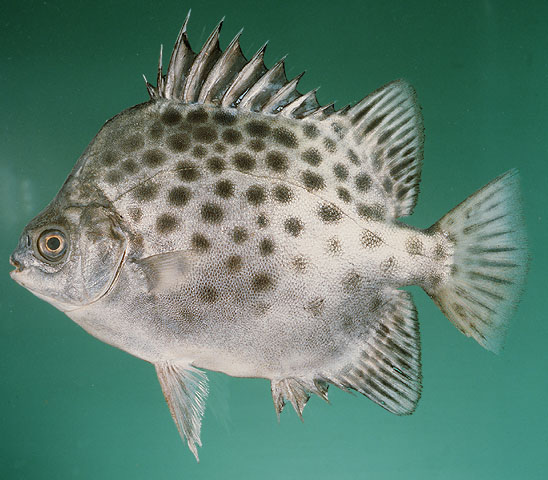| Scatophagidae (Scats) |
| 45 cm TL (male/unsexed) |
|
demersal; freshwater; brackish; marine; depth range 0 - 5 m, amphidromous |
| Indo-Pacific: Kuwait to Fiji, north to southern Japan, south to New Caledonia. Reported from Samoa (Ref. 9710), Tonga (Ref. 53797), and the Society Islands (Ref. 2847). |
|
Dorsal spines (total): 10-11; Dorsal soft rays (total): 16-18; Anal spines: 4-4; Anal soft rays: 13-15. Ground colour greenish. Juveniles with a few large roundish blotches, about size of eye, or with about 5 or 6 broad, dark, vertical bars. In large adults, spots may be faint and restricted to dorsal part of flanks. Body quadrangular, strongly compressed. Dorsal head profile steep. Eye moderately large, its diameter somewhat smaller than snout length. Snout rounded. Mouth small, horizontal, not protractile. Teeth villiform, in several rows on jaws (ref 43044). |
| Inhabit harbors, natural embayments, brackish estuaries and the lower reaches of freshwater streams, frequently occurring among mangroves. Feed on worms, crustaceans, insects and plant matter (Ref. 7020, 44894, 48637). The dorsal, anal and pelvic spines are believed by Philippine fishers to be venomous and capable of inflicting wounds (Ref. 6565). Used in Chinese medicine (Ref. 12166). In Hong Kong live fish markets (Ref. 27253). Marketed as fresh (Ref. 12693). |
|
Least Concern (LC); Date assessed: 04 February 2009 Ref. (130435)
|
| venomous |
Source and more info: www.fishbase.org. For personal, classroom, and other internal use only. Not for publication.

